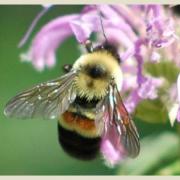
Skip the bread. Just watch instead!
Malnutrition, disease, habitat degradation, and habituation are serious consequences of feeding ducks and geese.

BEE on the Lookout for the Rusty Patched Bumble Bee
Maine Department of Inland Fisheries and Wildlife is looking for the federally Endangered Rusty Patched Bumble Bee and we need more eyes!

Happy Mother’s Day!
It only takes a quick look into the animal kingdom to see that motherhood comes in many forms.

Ring in the Spring with the Heron Observation Network – 13 Years and Counting
Of the many harbingers of spring, herons returning to their colonies is my favorite! Before we embark on the 14th year of heron colony monitoring, let's first review results from the 2021 volunteer efforts.
Spring is Here, but Where are Our Tagged Herons?
Spring is here, and we are patiently waiting for our tagged herons to return from their wintering areas. Here's an update explaining why we haven't seen them yet.

Signs of Spring
In Maine, March is the perfect time to start taking a moment here and there to notice the changing wildlife sights, sounds, and smells around you.

Tracking Nokomis Connected People to Place, Both Near and Far
As a biologist, I know death is as much a part of the life cycle of all organisms as life itself, but it can still be difficult to contend with especially after you’ve “gotten to know” an individual animal by following its movements for nearly five years. That individual is Nokomis, a great blue heron we tagged with a GPS transmitter in 2016.

A Quick Look Back Before the 2020 Heron Watching Season Begins
How about we forget about what’s going on in the crazy world for just a moment and think about the month of June 2019, which is when Heron Observation Network Volunteers conducted most of their colony visits last year.

Harper's Marvelous Migration Sparks More Questions - Here Are Some Answers
For those who may be late to the party, “Harper” is an adult female great blue heron who was captured and tagged with a GPS transmitter in Harpswell, Maine, by IFW biologists with the help of students from Harpswell Coastal Academy and volunteers with Harpswell Heritage Land Trust.

Heron Tagged in Harpswell Surprises Biologists
For nine students at Harpswell Coastal Academy, Wednesdays in May meant donning knee-high boots, venturing to a nearby wetland, and hoping for signs a hungry great blue heron had been there. As part of a spring class elective, these students were dedicated to helping MDIFW ultimately tag a great blue heron with a GPS transmitter as part of an ongoing project to better understand heron habits in Maine.
Keep In Touch!
Enter your email or mobile number to receive the latest news from MDIFW.